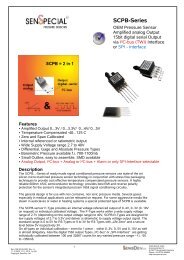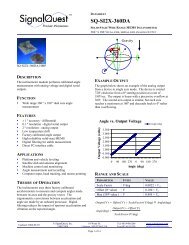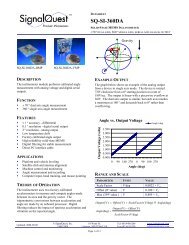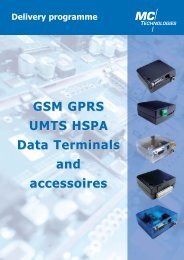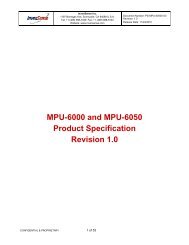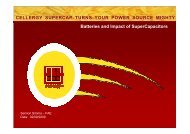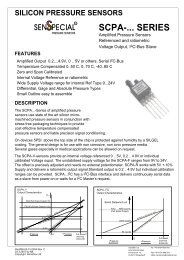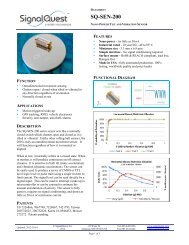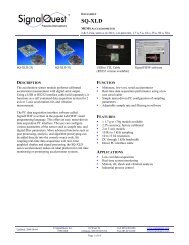ITG-3050 Product Specification Revision 1.3 - InvenSense
ITG-3050 Product Specification Revision 1.3 - InvenSense
ITG-3050 Product Specification Revision 1.3 - InvenSense
Create successful ePaper yourself
Turn your PDF publications into a flip-book with our unique Google optimized e-Paper software.
<strong>ITG</strong>-<strong>3050</strong> <strong>Product</strong> <strong>Specification</strong><br />
Document Number: PS-<strong>ITG</strong>-<strong>3050</strong>-00<br />
<strong>Revision</strong>: <strong>1.3</strong><br />
Release Date: 08/25/2011<br />
Data Format / Acknowledge<br />
I 2 C data bytes are defined to be 8 bits long. There is no restriction to the number of bytes transmitted per<br />
data transfer. Each byte transferred must be followed by an acknowledge (ACK) signal. The clock for the<br />
acknowledge signal is generated by the master, while the receiver generates the actual acknowledge signal<br />
by pulling down SDA and holding it low during the HIGH portion of the acknowledge clock pulse.<br />
If a slave is busy and is unable to transmit or receive another byte of data until some other task has been<br />
performed, it can hold SCL LOW, thus forcing the master into a wait state. Normal data transfer resumes<br />
when the slave is ready, and releases the clock line (refer to the following figure).<br />
DATA OUTPUT BY<br />
TRANSMITTER (SDA)<br />
DATA OUTPUT BY<br />
RECEIVER (SDA)<br />
not acknowledge<br />
acknowledge<br />
SCL FROM<br />
MASTER<br />
1 2 8 9<br />
START<br />
condition<br />
clock pulse for<br />
acknowledgement<br />
Acknowledge on the I 2 C Bus<br />
Communications<br />
After beginning communications with the START condition (S), the master sends a 7-bit slave address<br />
followed by an 8 th bit, the read/write bit. The read/write bit indicates whether the master is receiving data from<br />
or is writing to the slave device. Then, the master releases the SDA line and waits for the acknowledge<br />
signal (ACK) from the slave device. Each byte transferred must be followed by an acknowledge bit. To<br />
acknowledge, the slave device pulls the SDA line LOW and keeps it LOW for the high period of the SCL line.<br />
Data transmission is always terminated by the master with a STOP condition (P), thus freeing the<br />
communications line. However, the master can generate a repeated START condition (Sr), and address<br />
another slave without first generating a STOP condition (P). A LOW to HIGH transition on the SDA line while<br />
SCL is HIGH defines the stop condition. All SDA changes should take place when SCL is low, with the<br />
exception of start and stop conditions.<br />
SDA<br />
SCL<br />
1 – 7 8 9 1 – 7 8 9 1 – 7 8 9<br />
S<br />
START<br />
condition<br />
ADDRESS R/W ACK DATA ACK DATA ACK STOP<br />
condition<br />
Complete I 2 C Data Transfer<br />
P<br />
25 of 42



